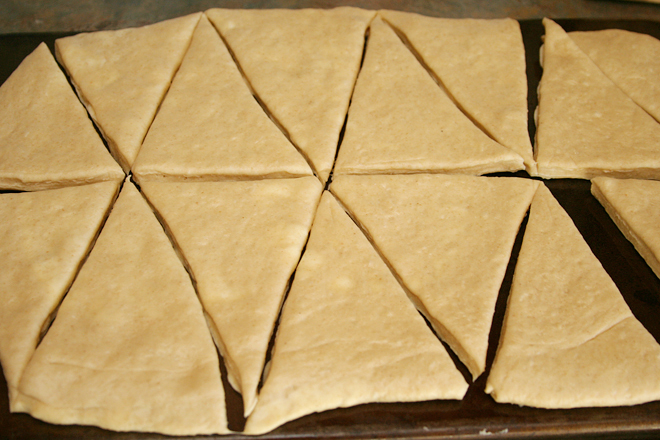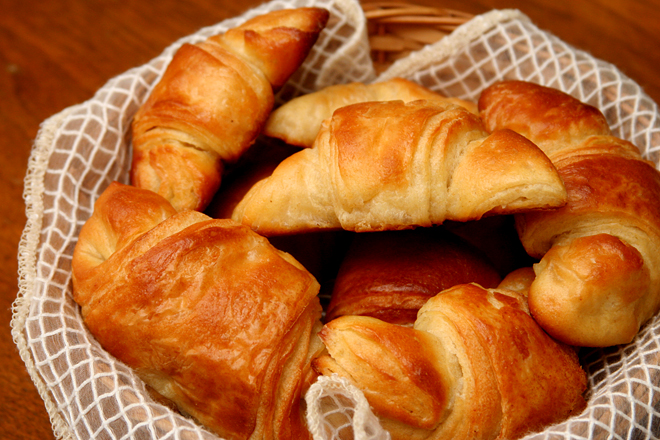I want my crescent rolls to bridge the gap between a regular dinner roll and a croissant. I want them intensely buttery, soft in the middle, with a slight crackle to the crust. I want the rolled layers to come apart when you bite into a browned edge. I don’t want them to be flaky; that’s too far down the croissant path. Basically, I want what you get when you pop open one of those tubes from the grocery store, except those tend to be soft to the point of mushy and too pale on the outside. It’s been surprisingly hard to find this ideal.
Most recipes turn out rolls that are too similar to dinner rolls, without enough butter and without distinct layers. The recipe I started from for these rolls looked like they’d go too far the other direction, with flaky layers of dough separated by butter, like a croissant. You get those layers through folding butter into the dough and rolling it flat, then folding the dough into thirds and rolling again. In a croissant, this process is repeated to make hundreds of alternating paper-thin dough and butter layers.
By reducing the number of turns, I was able to create the layers I wanted without making them so thin they’d turn flaky, so the dough layers were distinctly bread-like. The bread needed to be tender, which I guaranteed by adding a couple tablespoons of oil. The butter layers would add plenty of butter flavor, but the oil would keep the bread soft and moist. At last – the perfect crescent roll, halfway between a dinner roll and a croissant.
One year ago: Yogurt Hollandaise Sauce
Two years ago: Yellow Cake (comparison of 3 recipes)
Three years ago: Jalapeno Baked Fish with Roasted Tomatoes and Potatoes
Four years ago: Pot Roast
Five years ago: Salmon Cakes, Flaky Biscuits, Hashed Brussels Sprouts
Printer Friendly Recipe
Crescent Rolls (adapted from eat live run)
Makes 16 rolls
I made these slightly whole wheat by using this trick, but if you’d rather they were made completely with white flour, just skip step one, adding the pre-dough ingredients (white flour instead of whole wheat) with the rest of the dough ingredients.
Pre-dough:
4 ounces (about ¾ cup) whole wheat flour
⅓ cup (2.67 ounces) water
¼ teaspoon salt
Dough:
2½ cups (12 ounces) all-purpose flour
2 teaspoons instant yeast
2 tablespoons sugar
¾ teaspoon salt
¾ cup milk plus 1 tablespoon
1 egg
2 tablespoons vegetable or canola oil
6 tablespoons butter, softened
egg wash
1. For the pre-dough: Combine the flour, salt, and water, mixing until a shaggy dough forms. Cover and set aside at room temperature for at least 8 hours or overnight.
2. Combine the pre-dough, flour, yeast, sugar, salt, ¾ cup milk, egg, and oil in the bowl of a stand mixer. Knead about 4 minutes. (You can mix and knead the dough by hand in a large bowl.) Cover and refrigerate for 1 hour.
3. Roll the dough out to about ¼-inch thick. Starting at a short end, spread the softened butter over two-thirds of the dough. Fold the unbuttered third of dough over the buttered middle. Fold the other buttered side over the middle. You’ve just folded the dough in thirds, like a letter, with the butter trapped inside between layers of dough. Wrap the dough in plastic wrap and chill 30 minutes. Roll out to ¼-inch thick again; fold in thirds again; chill another 30 minutes.
4. Roll the dough to ¼-inch thick to a rectangle about 10 by 14-inches. Slice in half lengthwise, creating two 5 by 14-inch rectangles, then alternate diagonal cuts to make 8 triangles from each half of dough. Cut a 1-inch slit in the wide end of each triangle (the side opposite the point). Roll up the triangles, starting at the wide end and pulling the corners away from the slit in the middle. Arrange the rolls on parchment- or silicone-lined baking sheets, about 2 inches apart. Spray with nonstick spray, cover with plastic wrap and let rise until doubled in size, about 1 hour.
5. Meanwhile, heat the oven to 400 degrees. About 5 minutes before baking, remove the plastic wrap and brush the rolls with the egg wash; leave them uncovered. Bake until golden brown, about 18 minutes.











storebought tube crescent rolls are good but always lacking…this recipe looks like a winner! yum!
Thank you Bridget for creating exactly what I want. I can’t wait to try this recipe. I’ll let you know how it goes. Thanks much!
Bridget, These crescent rolls look amazing! We are just stopping by your blog to say Hi! We would love to have you link up to our Strut Your Stuff Saturday link party and share some of your delicious recipes! We loved looking over all the yummy food!!! 🙂 Have a great week! -The Six Sisters
These look great! But what’s the filling they’re photographed with?
Jenn – I made these for a Thanksgiving-style dinner in January, so the next day I made sandwiches with turkey, cranberry sauce, and Hatch green chile.
Quick question. I don’t see where the 2 tablespoons of oil is incorporated into anything. Is that for greasing the bow/dough while it rises?
Ajax – Sorry about that. The oil is supposed to be incorporated into the dough. I’ll edit the recipe to include that instruction.
Did you add more butter in the second set of folding in step 3? I think I’m going to bake a batch this weekend…
matt – Nope, just the one layer of butter, which, after all the folds, gets dispersed into a bunch of layers. Let me know how it goes!
You list an egg for egg wash but in the instructions you say milk . So just wondering which to do.
cristy – Sorry the ingredients list didn’t match the recipe instructions. I fixed that. I use whichever is most convenient – an egg wash works better, but I hate cracking an egg and using just a tiny amount of it, so often I’ll use milk, maybe mixed with a dab of cornstarch (to make it thicker) and sugar (to make it brown more). For the rolls shown in the pictures here, I used egg wash.